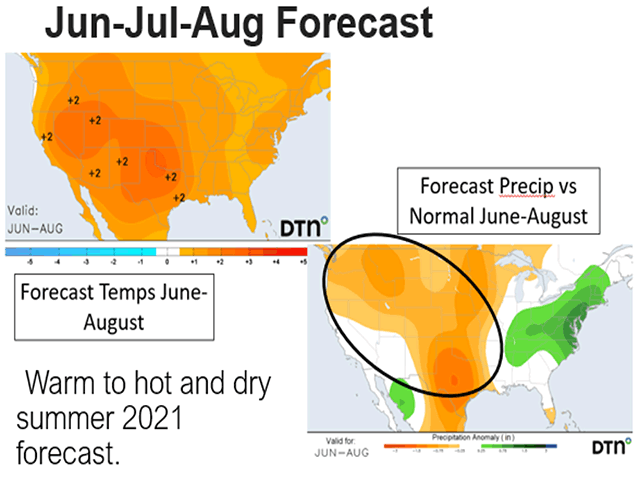Todd's Take
Is It Time for a Texas Hedge in Soybeans?
On May 12, 2021, USDA is going to present its first World Agricultural Supply and Demand Estimates (WASDE) report including the 2021-22 season, and this is a report I'm looking forward to seeing. For soybeans, USDA will likely use its March 31 planting estimate of 87.6 million acres, estimating production somewhere near 4.400 billion bushels (bb).
In February, USDA estimated 4.53 bb of total demand for U.S. soybeans in 2021-22, leaving a production deficit of 130 million bushels (mb) in this scenario. The problem is that USDA only estimates a surplus of 120 mb in the current season and even that is inflated. Total soybean export commitments are within 47 mb of USDA's export estimate with four-and-a-half months left in 2020-21.
In the real world, there is a good chance soybean plantings will be closer to 90.0 million acres in 2021, and higher imports can help ease the pain of tight supplies this summer. The one thing there is no room for in this new-crop scenario, however, is adverse weather. If soybeans can't reasonably attain a national yield of something close to 50.8 bushels per acre, all bets are off. There is potential here for new-crop soybean prices to exceed the 2012 spot high of $17.89 a bushel.
Before you run out and load up on soybean futures or call options, let's take a closer look. Here in mid-April, the U.S. Drought Monitor shows severe to extreme drought in most of North Dakota and western South Dakota. Abnormally dry areas are teasing parts of Iowa and Illinois.
In DTN's Market Weather Outlook on April 15, 2021, Senior Meteorologist Bryce Anderson showed the DTN forecast for June to August, highlighting above-normal temperatures for the entire U.S. and below-normal precipitation for much of the central and western U.S. Plains. Only the eastern Midwest and states along the Atlantic coast show chances for above-normal precipitation. Long-term forecasts are not sure bets, but the early slant is bullish.
So far in 2020-21, China has purchased 1.32 bb of soybeans from the U.S., leaving just enough supply to survive the summer. China is now a heavy buyer of soybeans in Brazil and purchases have been so aggressive that Brazil's FOB soybean price for May just hit a new one-month high of $528.75 per metric ton on Thursday (April 15). That's right, a new one-month high in the latter stage of a soybean harvest that is estimated close to 5.0 bb.
P[L1] D[0x0] M[300x250] OOP[F] ADUNIT[] T[]
If that's not a sign of strong demand, then maybe I should also mention that DTN's National Soybean Index of cash prices just closed 25 cents below the May futures contract Wednesday (April 14), the strongest basis in eight years.
No matter how you look at it, there is no margin for adverse weather in soybeans in 2021 and that turns my interest to the prices of soybean options. November soybean options expire Oct. 22, 2021, so there is plenty of time to benefit from dry, summer weather, should it happen.
November soybean futures closed at $12.69 Thursday, April 15. A November $12 call closed at $1.10 or $5,500 for a single 5,000-bushel contract. While the $12 call would be quickly responsive to higher prices, $5,500 represents almost 9% of the contract's value and is a heavy risk for an option.
A November $16 soybean call closed at 15 cents Thursday. The $750 cost is clearly less risk than the $5,500 call mentioned above. The downside is, if November soybeans rally all the way to $15.99 on expiration day, the $750 is lost. In the same scenario, the $12 call could be sold for $19,950 and earn a theoretical profit of $14,450 (commissions and slippage not included).
For anyone interested in buying a November soybean call, perhaps something between a $12 and a $16 call is more appealing. Suppose you buy a November $13 soybean call at Thursday's close of 68 cents, for a theoretical cost of $3,400. According to USDA, it will cost $466.34 to plant and produce an acre of soybeans in 2021. In this case, the same $3,400 used to buy a November $13 call could also be used to plant a little over seven acres of soybeans.
The good news is that by planting soybeans, there is much less risk of being completely wiped out than there is owning a call option. The downside of planting soybeans is that if soybeans go to $18 a bushel, the venture is going to make about $448 per acre or $3,266 for the 7.3-acre plot. The November $13 call, on the other hand, would theoretically pocket $21,600 (not including commissions and slippage).
It is not my intention to motivate producers to go out and buy a bunch of soybean calls this year, and please don't have your bankers call me. I go through the simple exercises above, not to whip anyone into a bullish frenzy, but to show there is a responsible way to risk a limited amount of money in this unusually bullish situation that could add to the bottom line.
Honestly, I hesitate to bring the subject up at all, knowing that some have a penchant for going to extremes. But starting the year with so many bullish factors, I suspect many are already thinking about ways of taking advantage of the situation. Whatever you do in 2021, don't get carried away with increasing your risk, no matter how bullish things get.
Best wishes for a good year.
**
Comments above are for educational purposes only and are not meant as specific trade recommendations. The buying and selling of grain or grain futures or options involve substantial risk and are not suitable for everyone.
Todd Hultman can be reached at Todd.Hultman@dtn.com
Follow him on Twitter @ToddHultman1
(c) Copyright 2021 DTN, LLC. All rights reserved.




